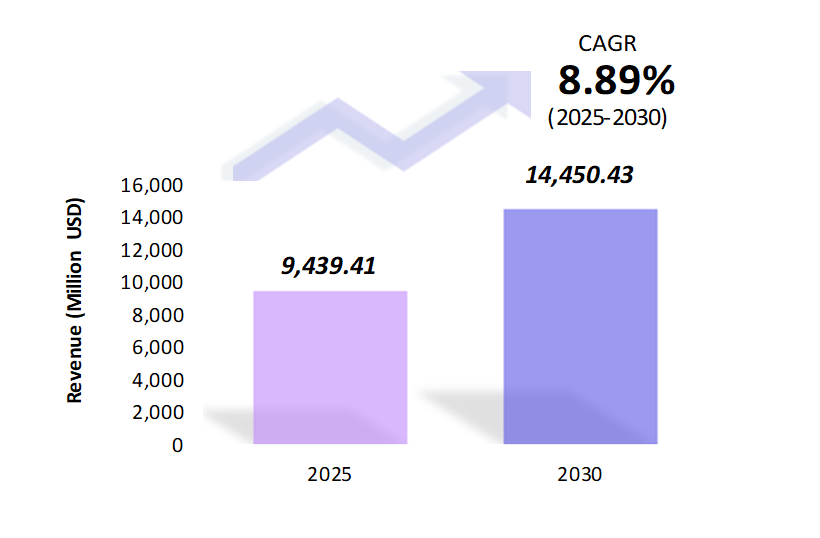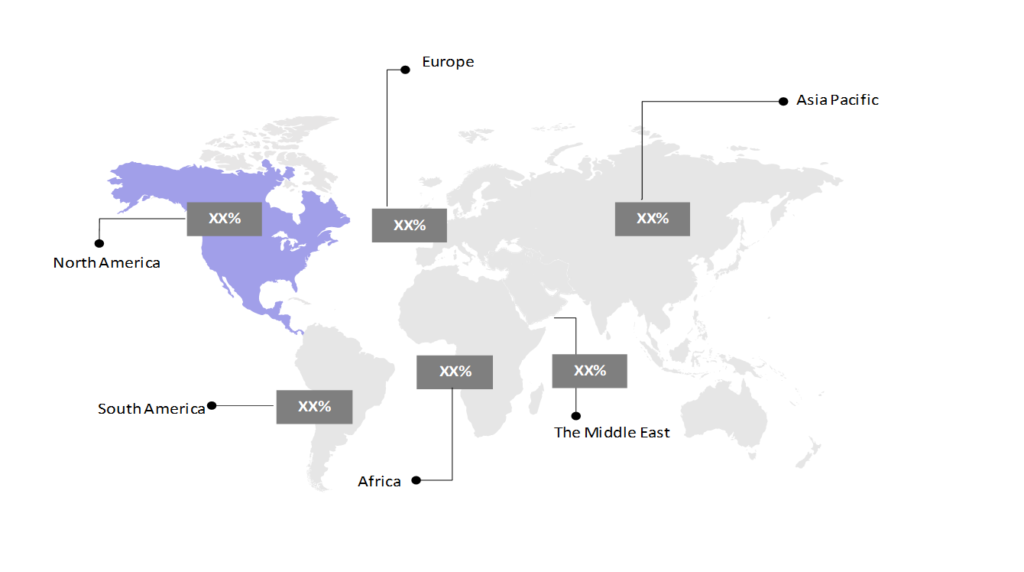Portable X-ray Devices Market Insights: Size, Share, Growth Analysis & Forecast (2024-2029)
The market report provided a comprehensive analysis segmented by Technology (Analog X-ray, Digital X-ray); by Application (Dental X-ray, Mammography, Chest X-ray, Abdomen X-ray); by Geography (North America, South America, Asia Pacific, Europe, The Middle East, Africa).
Outlook

- The portable x-ray devices market is estimated to be at USD 9,439.41 Mn in 2025 and is anticipated to reach USD 14,450.43 Mn in 2030.
- The portable x-ray devices market is registering a CAGR of 8.89% during the forecast period 2025-2030.
- The portable X-ray device market is experiencing significant growth due to increasing demand for technological advancements in digital imaging. Innovations such as Artificial Intelligence (AI) integration and enhanced portability are driving adoption across various healthcare settings, including emergency rooms and home healthcare. With ongoing research and development supported by both private and government funding, the market is poised for further expansion.
Request a free sample.
Ecosystem

- The participants in the global portable X-ray devices industry are always developing their strategies to preserve a competitive advantage.
- Companies are prioritizing innovations in AI integration, wireless connectivity, and improved imaging technology to differentiate their products and address specific healthcare needs.
- Several important entities in the portable X-ray devices market include General Electric Co.; Canon Inc.; MinXray, Inc.; Envista Holdings Corp.; Koninklijke Philips N.V.; and others.
Ask for customization.
Findings
| Attributes | Values |
|---|---|
| Historical Period | 2019-2023 |
| Base Year | 2024 |
| Forecast Period | 2025-2030 |
| Market Size (2025) | USD 9,439.41 Mn |
| Market Size (2030) | USD 14,450.43 Mn |
| Growth Rate | 8.89% CAGR from 2025 to 2030 |
| Key Segments | Technology (Analog X-ray, Digital X-ray); Application (Dental X-ray, Mammography, Chest X-ray, Abdomen X-ray); Geography (North America, South America, Asia Pacific, Europe, The Middle East, Africa) |
| Key Vendors | General Electric Co.; Canon Inc.; MinXray, Inc.; Envista Holdings Corp.; Koninklijke Philips N.V. |
| Key Countries | The US; Canada; Mexico; Brazil; Argentina; China; India; The UK; Germany; Italy; France; UAE; Saudi Arabia; Egypt; South Africa |
| Largest Market | North America |
Get a free quote.
Trends
- AI-Powered Image Analysis: Integration of AI algorithms into portable X-ray devices allows real-time image analysis, enhancing diagnostic accuracy and reducing human error. AI-based tools can assist radiologists by highlighting potential abnormalities, such as fractures or lung issues, which enables faster decision-making in critical situations. Qure.ai, an AI healthcare startup, developed a solution called qXR, which uses AI to analyze chest X-rays. This tool was integrated into portable X-ray devices in hospitals and clinics to assist radiologists in identifying signs of COVID-19, such as lung consolidations and ground-glass opacities.
- Wireless Connectivity and Cloud Integration: New portable X-ray machines come with wireless capabilities, which allow seamless data transfer to cloud systems or hospital networks. This ensures instant sharing of images with radiologists, reducing waiting times and improving patient care efficiency. Devices with cloud integration are used in rural clinics, where specialists can remotely access and review X-rays in real time.
- Development of Point-of-Care (POC) X-ray Systems: Recent developments include compact X-ray devices designed specifically for point-of-care (POC) settings such as ICUs and operating rooms. These systems allow for bedside imaging, which reduces the need to move critically ill patients to radiology departments and minimizes the risk of complications. POC X-ray devices are used in neonatal care units to avoid moving premature babies for diagnostic imaging.
Speak to analyst.
Catalysts
- Technological Advancements in Digital Imaging: The transition from analog to digital X-ray systems, including advancements in flat-panel detectors and improved image quality, has made portable X-ray devices more efficient and easier to use. Digital systems enable faster image acquisition, easy storage, and seamless integration with hospital IT systems, such as PACS (Picture Archiving and Communication Systems). Digital portable X-ray machines in orthopedic clinics allow for quick, precise bone imaging and immediate image review.
- Growing Geriatric Population and Home Healthcare Demand: The increasing elderly population with chronic diseases like osteoporosis, arthritis, and cardiovascular conditions is driving the need for mobile diagnostic tools that can be used in home healthcare settings. Portable X-ray systems provide a convenient solution for in-home imaging, which minimizes hospital visits and enhances patient comfort. Visiting Nurse Associations (VNAs) in the US VNAs provide healthcare services to homebound patients, particularly the elderly, who have chronic conditions such as osteoporosis, arthritis, or cardiovascular diseases.
- Huge Funding for R&D of Portable Technologies by Private Players and Governments: Significant investments from private companies and governments are driving innovation in portable X-ray devices, focusing on improving portability and image quality. Government support, particularly for rural healthcare and emergency response, is strengthening medical infrastructure. The US Department of Defense and companies like Siemens Healthineers and GE Healthcare are investing in R&D to advance battlefield and AI-enhanced portable X-ray technology.
Inquire before buying.
Restraints
- Stringent Regulatory Scenario: Portable X-ray devices face complex regulatory requirements from health and safety authorities, such as the Food and Drug Administration (FDA) and European Union (EU) medical device regulations, which can slow down product development and approval timelines. Compliance with these stringent standards, particularly regarding safety, performance, and radiation control, poses significant challenges for manufacturers, which increases development costs and time-to-market.
- High Risk of Radiation Exposure: Despite advancements, portable X-ray devices still present risks related to radiation exposure, both for patients and healthcare workers. This challenge is particularly concerning in frequent-use settings such as emergency rooms and mobile clinics. Ensuring effective shielding and minimizing radiation doses while maintaining image quality is a critical concern for manufacturers, often requiring additional safety features that can increase device complexity and cost.
- High Initial Costs of Portable X-ray Devices: The initial investment required for portable X-ray systems can be significant, which may deter healthcare facilities, especially smaller clinics or rural providers, from adopting this technology. While portable devices offer long-term cost savings and improved patient care, the upfront costs for advanced features can pose a financial barrier, which limits their accessibility in resource-constrained settings.
Personalize this research.
Hotspot

Explore purchase options.
Table of Contents
| 1. Introduction 1.1. Research Methodology 1.2. Scope of the Study 2. Market Overview / Executive Summary 2.1. Global Portable X Ray Devices Market (2019 – 2023) 2.2. Global Portable X Ray Devices Market (2024 – 2030) 3. Market Segmentation 3.1. Global Portable X Ray Devices Market by Technology 3.1.1. Analog X-ray 3.1.2. Digital X-ray 3.2. Global Portable X Ray Devices Market by Application 3.2.1. Dental X-ray 3.2.2. Mammography 3.2.3. Chest X-ray 3.2.4. Abdomen X-ray 4. Regional Segmentation 4.1. North America 4.1.1. The US 4.1.2. Canada 4.1.3. Mexico 4.2. South America 4.2.1. Brazil 4.2.2. Argentina 4.2.3. Rest of South America 4.3. Asia Pacific 4.3.1. China 4.3.2. India 4.3.3. Rest of Asia Pacific 4.4. Europe 4.4.1. The UK 4.4.2. Germany 4.4.3. Italy 4.4.4. France 4.4.5. Rest of Europe 4.5. The Middle East 4.5.1. UAE 4.5.2. Saudi Arabia 4.5.3. Rest of the Middle East 4.6. Africa 4.6.1. Egypt 4.6.2. South Africa 4.6.3. Rest of Africa 5. Value Chain Analysis of the Global Portable X Ray Devices Market 6. Porter Five Forces Analysis 6.1. Threats of New Entrants 6.2. Threats of Substitutes 6.3. Bargaining Power of Buyers 6.4. Bargaining Power of Suppliers 6.5. Competition in the Industry 7. Trends, Drivers and Challenges Analysis 7.1. Market Trends 7.1.1. Market Trend 1 7.1.2. Market Trend 2 7.1.3. Market Trend 3 7.2. Market Drivers 7.2.1. Market Driver 1 7.2.2. Market Driver 2 7.2.3. Market Driver 3 7.3. Market Challenges 7.3.1. Market Challenge 1 7.3.2. Market Challenge 2 7.3.3. Market Challenge 3 8. Opportunities Analysis 8.1. Market Opportunity 1 8.2. Market Opportunity 2 8.3. Market Opportunity 3 9. Competitive Landscape 9.1. General Electric Co. 9.2. Canon Inc. 9.3. MinXray, Inc. 9.4. Envista Holdings Corp. 9.5. Koninklijke Philips N.V. 9.6. Company 6 9.7. Company 7 9.8. Company 8 9.9. Company 9 9.10. Company 10 |
Know the research methodology.
Portable X-ray Devices Market – FAQs
1. What is the current size of the portable x-ray devices market?
Ans. In 2025, the portable x-ray devices market size is USD 9,439.41 Mn.
2. Who are the major vendors in the portable x-ray devices market?
Ans. The major vendors in the portable x-ray devices market are General Electric Co.; Canon Inc.; MinXray, Inc.; Envista Holdings Corp.; Koninklijke Philips N.V.
3. Which segments are covered under the portable X-ray devices market segments analysis?
Ans. The portable X-ray devices market report offers in-depth insights into Technology, Application, and Geography.
